Abstract
To establish clinical and histologic determinants of survival, records of all UCLA patients with resectable melanoma metastatic to the lymph nodes during the years 1954-1976 were reviewed. These 150 patients were treated first with wide excision, lymphadenectomy, and with radiation/chemotherapy and/or additional surgery only if further recurrences developed. None received adjuvant immunotherapy or chemotherapy. In 97 of 139 patients with identified primary tumors, slides of the primary lesion were reviewed. Putative prognostic factors included age, sex, parity, site of primary tumor, presence of satellitosis, clinical status of nodes, histologic characteristics of primary lesion (Clark's level, thickness of tumor, presence/width of ulceration, and number of mitoses/HPF), time from biopsy of primary tumor to lymphadenectomy, and number of positive nodes. kaplan-Meier estimates of survival for the entire group at one, two, five, and ten years were 73, 55, 37, and 33%, respectively. Median follow-up period of survivors was four years. Univariate analyses using the log-rank test showed that thickness of the primary lesion (p less than 0.001), width of ulceration (p = 0.003), absence of ulceration (p = 0.024), and number of positive nodes (p = 0,.033) were prognostic for survival. In multivariate analysis by the Cox procedure, thickness of the primary (p = 0.001) and number of melanoma-containing nodes (p = 0.043) were prognostic for survival. Location of the primary tumor became marginally significant (p = 0.12) in the multrivariate model. These findings demonstrate the prognostic importance of characteristics of both the primary lesion and extent of regional dissemination. Future prospective randomized trials for (adjuvant) therapy of Stage II melanoma should be stratified by these variables.
Full text
PDF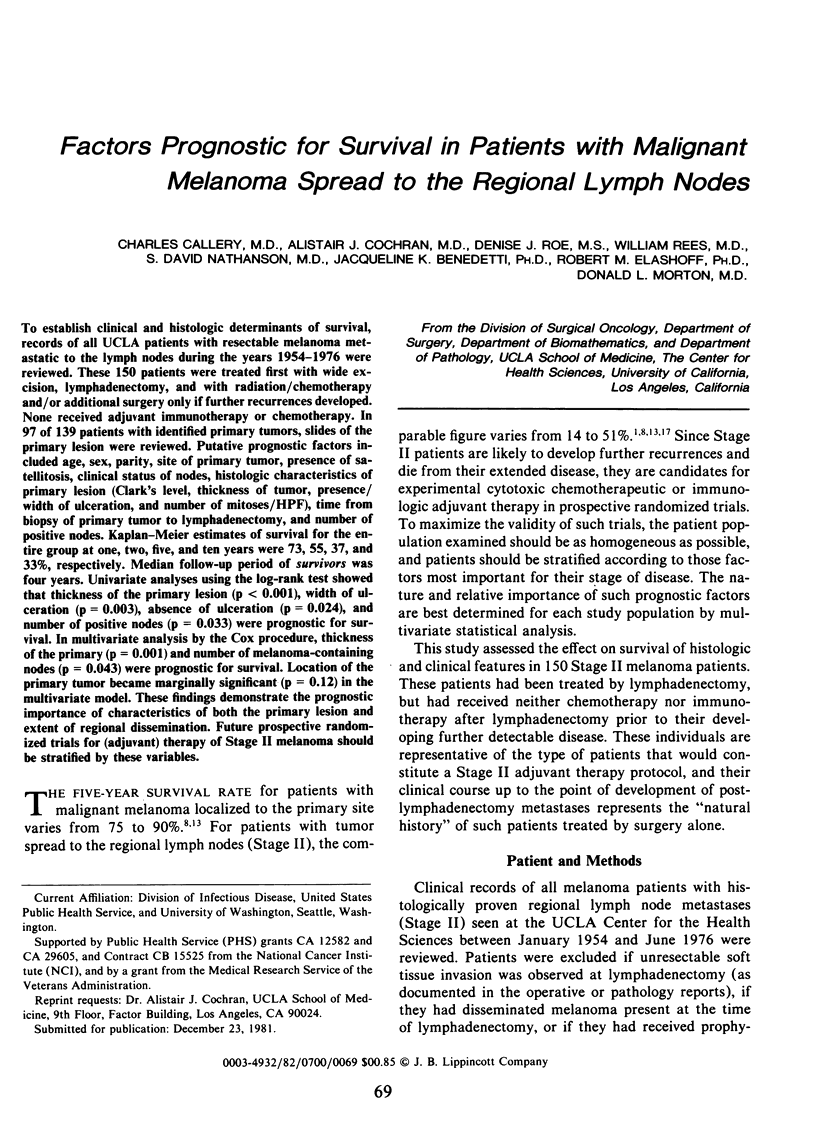
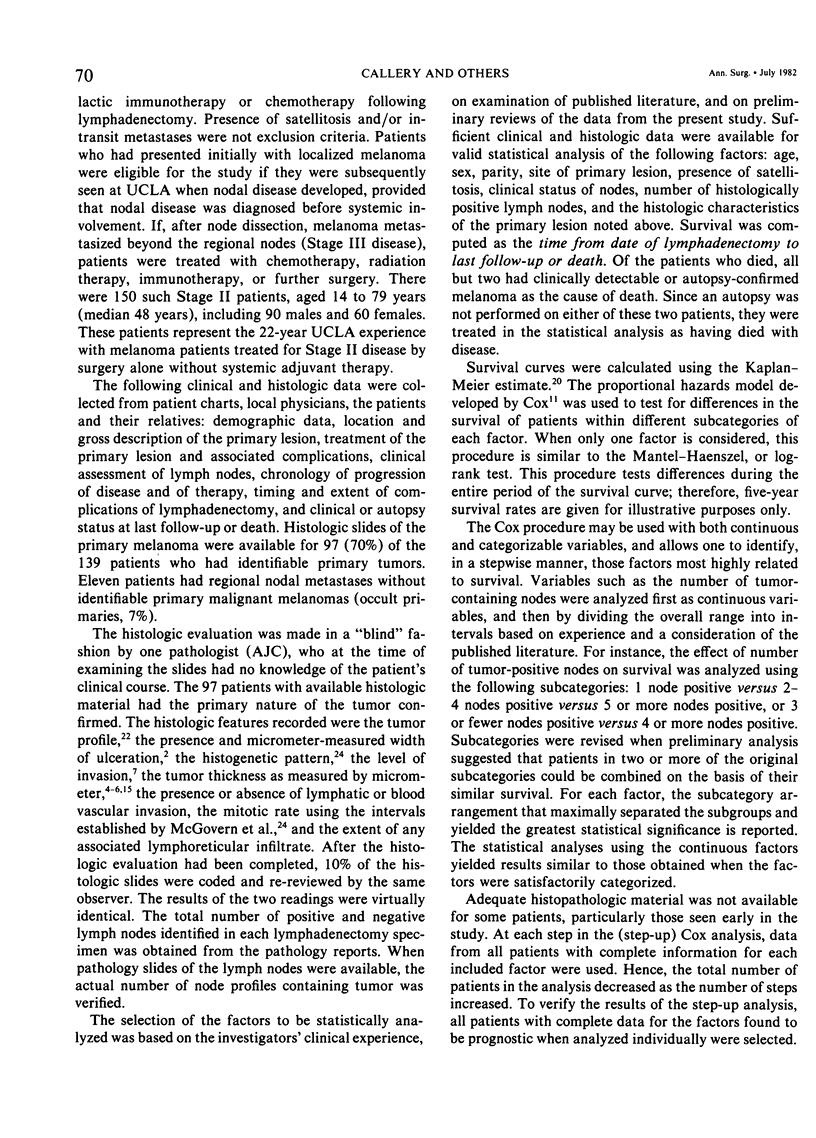
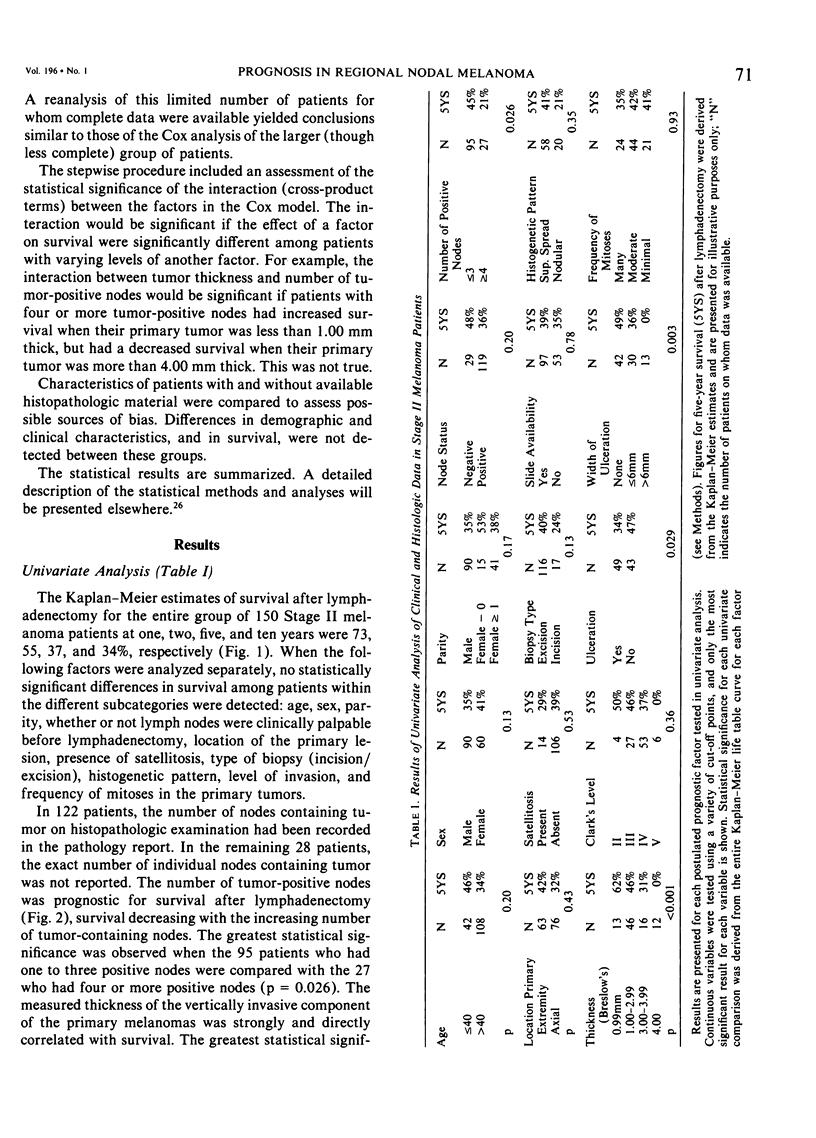
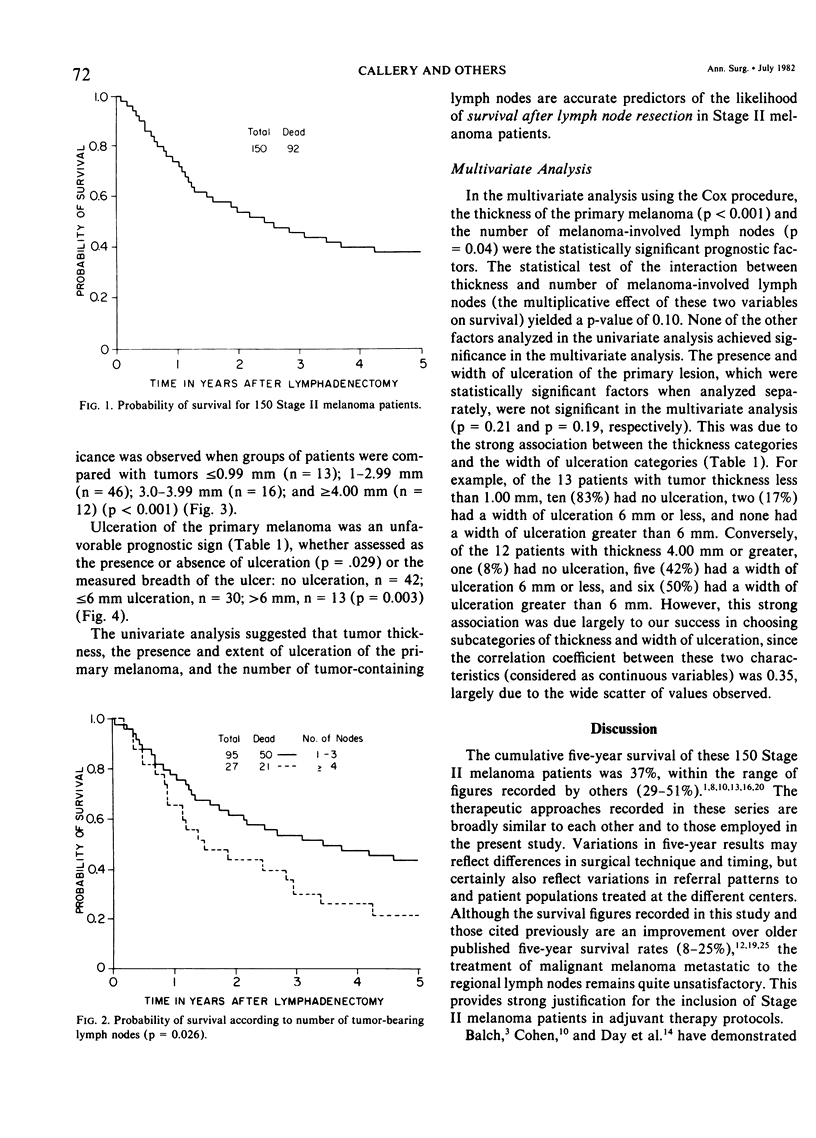
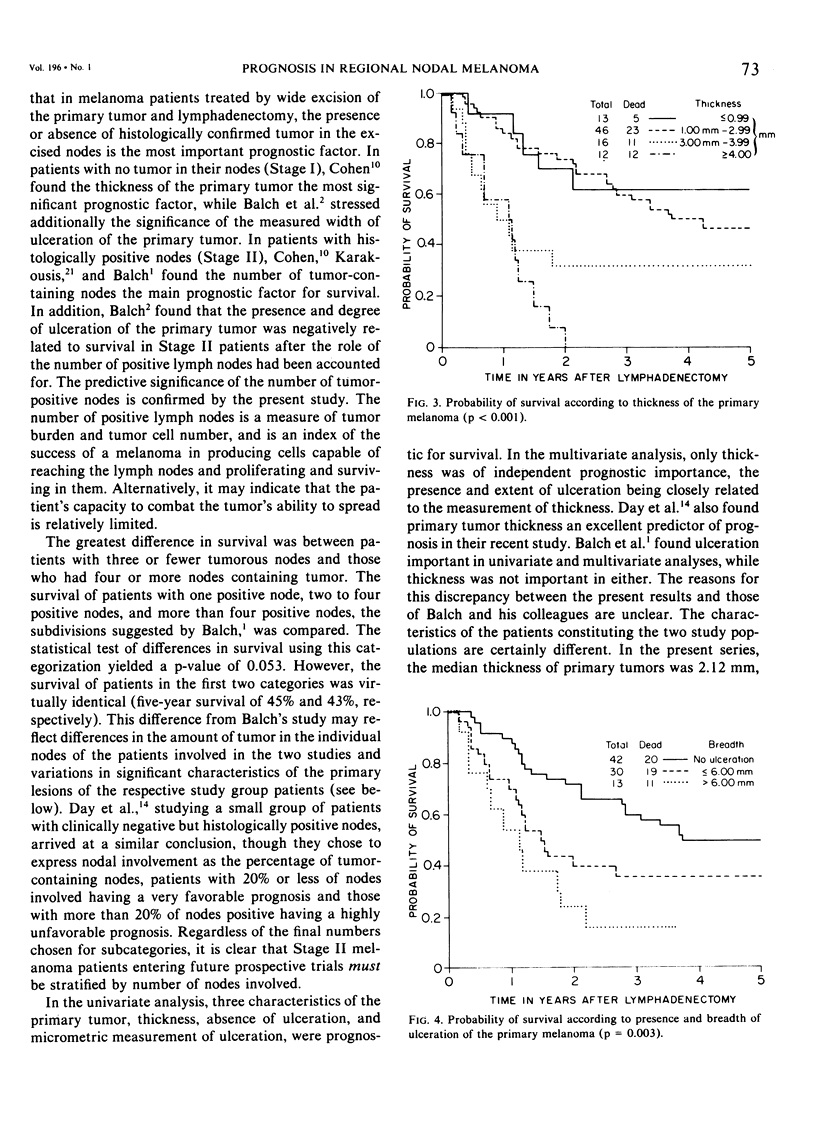
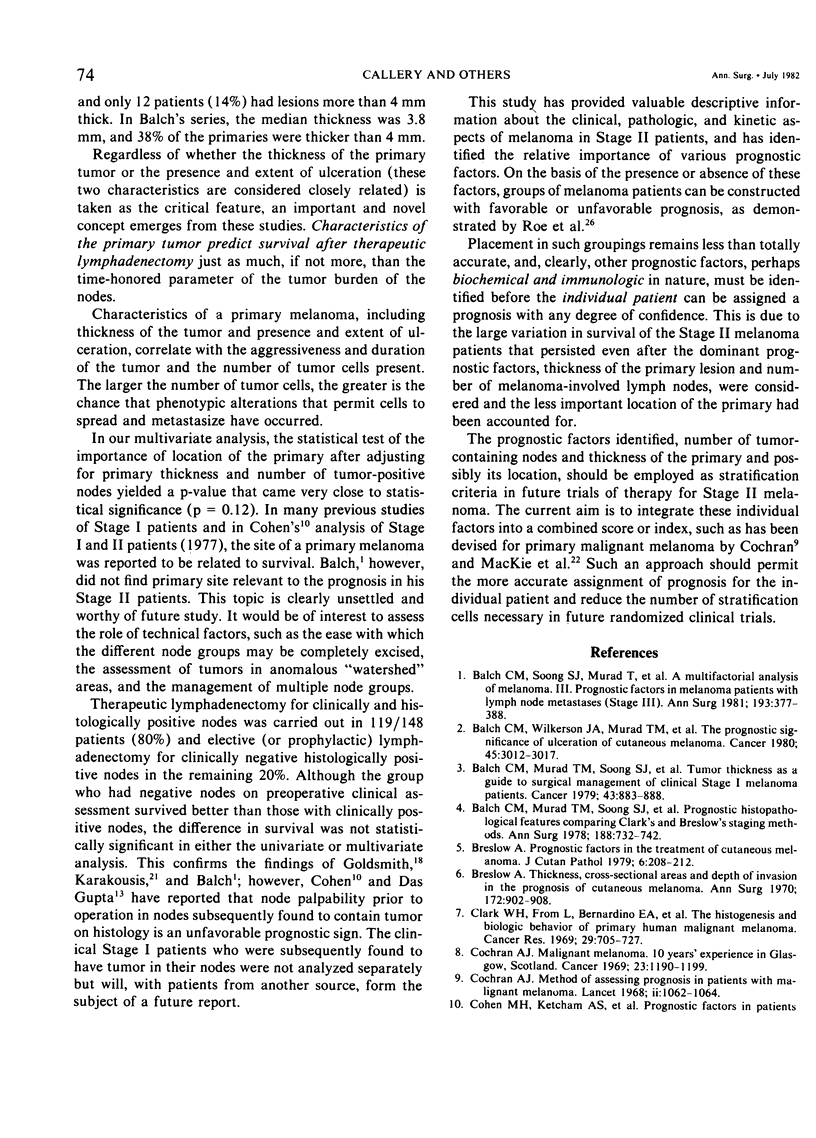
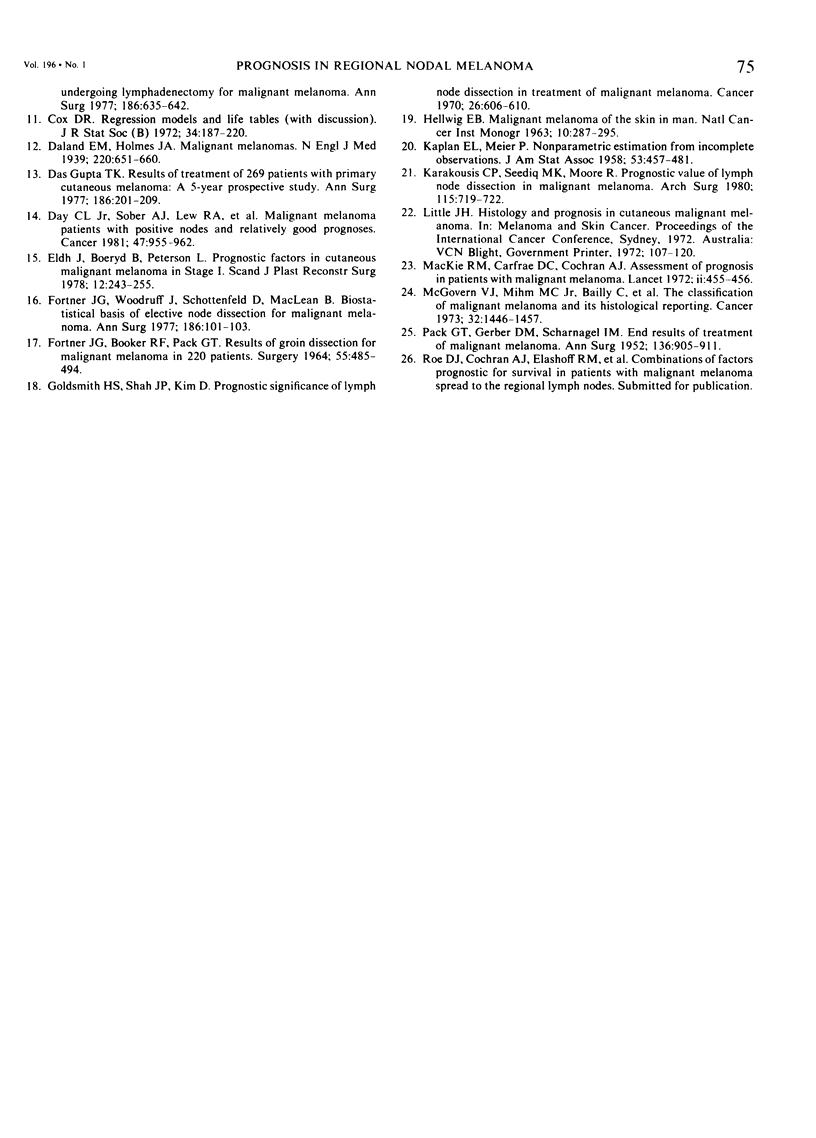
Selected References
These references are in PubMed. This may not be the complete list of references from this article.
- Balch C. M., Murad T. M., Soong S. J., Ingalls A. L., Halpern N. B., Maddox W. A. A multifactorial analysis of melanoma: prognostic histopathological features comparing Clark's and Breslow's staging methods. Ann Surg. 1978 Dec;188(6):732–742. doi: 10.1097/00000658-197812000-00004. [DOI] [PMC free article] [PubMed] [Google Scholar]
- Balch C. M., Murad T. M., Soong S. J., Ingalls A. L., Richards P. C., Maddox W. A. Tumor thickness as a guide to surgical management of clinical stage I melanoma patients. Cancer. 1979 Mar;43(3):883–888. doi: 10.1002/1097-0142(197903)43:3<883::aid-cncr2820430316>3.0.co;2-v. [DOI] [PubMed] [Google Scholar]
- Balch C. M., Soong S. J., Murad T. M., Ingalls A. L., Maddox W. A. A multifactorial analysis of melanoma: III. Prognostic factors in melanoma patients with lymph node metastases (stage II). Ann Surg. 1981 Mar;193(3):377–388. doi: 10.1097/00000658-198103000-00023. [DOI] [PMC free article] [PubMed] [Google Scholar]
- Balch C. M., Wilkerson J. A., Murad T. M., Soong S. J., Ingalls A. L., Maddox W. A. The prognostic significance of ulceration of cutaneous melanoma. Cancer. 1980 Jun 15;45(12):3012–3017. doi: 10.1002/1097-0142(19800615)45:12<3012::aid-cncr2820451223>3.0.co;2-o. [DOI] [PubMed] [Google Scholar]
- Breslow A. Prognostic factors in the treatment of cutaneous melanoma. J Cutan Pathol. 1979 Jun;6(3):208–212. doi: 10.1111/j.1600-0560.1979.tb01125.x. [DOI] [PubMed] [Google Scholar]
- Breslow A. Thickness, cross-sectional areas and depth of invasion in the prognosis of cutaneous melanoma. Ann Surg. 1970 Nov;172(5):902–908. doi: 10.1097/00000658-197011000-00017. [DOI] [PMC free article] [PubMed] [Google Scholar]
- Clark W. H., Jr, From L., Bernardino E. A., Mihm M. C. The histogenesis and biologic behavior of primary human malignant melanomas of the skin. Cancer Res. 1969 Mar;29(3):705–727. [PubMed] [Google Scholar]
- Cochran A. J. Malignant melanoma. A REVIEW OF ') YEARS' experience in Glasgow, Scotland. Cancer. 1969 May;23(5):1190–1199. doi: 10.1002/1097-0142(196905)23:5<1190::aid-cncr2820230527>3.0.co;2-y. [DOI] [PubMed] [Google Scholar]
- Cochran A. J. Method of assessing prognosis in patients with malignant melanoma. Lancet. 1968 Nov 16;2(7577):1062–1064. doi: 10.1016/s0140-6736(68)91532-8. [DOI] [PubMed] [Google Scholar]
- Cohen M. H., Ketcham A. S., Felix E. L., Li S. H., Tomaszewski M. M., Costa J., Rabson A. S., Simon R. M., Rosenberg S. A. Prognostic factors in patients undergoing lymphadenectomy for malignant melanoma. Ann Surg. 1977 Nov;186(5):635–642. doi: 10.1097/00000658-197711000-00016. [DOI] [PMC free article] [PubMed] [Google Scholar]
- Day C. L., Jr, Sober A. J., Lew R. A., Mihm M. C., Jr, Fitzpatrick T. B., Kopf A. W., Harris M. N., Gumport S. L., Raker J. W., Malt R. A. Malignant melanoma patients with positive nodes and relatively good prognoses: microstaging retains prognostic significance in clinical stage I melanoma patients with metastases to regional nodes. Cancer. 1981 Mar 1;47(5):955–962. doi: 10.1002/1097-0142(19810301)47:5<955::aid-cncr2820470523>3.0.co;2-1. [DOI] [PubMed] [Google Scholar]
- Eldh J., Boeryd B., Peterson L. E. Prognostic factors in cutaneous malignant melanoma in stage I. A clinical, morphological and multivariate analysis. Scand J Plast Reconstr Surg. 1978;12(3):243–255. doi: 10.3109/02844317809013000. [DOI] [PubMed] [Google Scholar]
- FORTNER J. G., BOOHER R. J., PACK G. T. RESULTS OF GROIN DISSECTION FOR MALIGNANT MELANOMA IN 220 PATIENTS. Surgery. 1964 Apr;55:485–494. [PubMed] [Google Scholar]
- Fortner J. G., Woodruff J., Schottenfeld D., Maclean B. Biostatistical basis of elective node dissection for malignant melanoma. Ann Surg. 1977 Jul;186(1):101–103. doi: 10.1097/00000658-197707000-00014. [DOI] [PMC free article] [PubMed] [Google Scholar]
- Goldsmith H. S., Shah J. P., Kim D. H. Prognostic significance of lymph node dissection in the treatment of malignant melanoma. Cancer. 1970 Sep;26(3):606–609. doi: 10.1002/1097-0142(197009)26:3<606::aid-cncr2820260317>3.0.co;2-m. [DOI] [PubMed] [Google Scholar]
- Gupta T. K. Results of treatment of 269 patients with primary cutaneous melanoma: a five-year prospective study. Ann Surg. 1977 Aug;186(2):201–209. doi: 10.1097/00000658-197708000-00013. [DOI] [PMC free article] [PubMed] [Google Scholar]
- Karakousis C. P., Seddiq M. K., Moore R. Prognostic value of lymph node dissection in malignant melanoma. Arch Surg. 1980 Jun;115(6):719–722. doi: 10.1001/archsurg.1980.01380060021006. [DOI] [PubMed] [Google Scholar]
- Mackie R. M., Carfrae D. C., Cochran A. J. Assessment of prognosis in patients with malignant melanoma. Lancet. 1972 Sep 2;2(7775):455–456. doi: 10.1016/s0140-6736(72)91854-5. [DOI] [PubMed] [Google Scholar]
- McGovern V. J., Mihm M. C., Jr, Bailly C., Booth J. C., Clark W. H., Jr, Cochran A. J., Hardy E. G., Hicks J. D., Levene A., Lewis M. G. The classification of malignant melanoma and its histologic reporting. Cancer. 1973 Dec;32(6):1446–1457. doi: 10.1002/1097-0142(197312)32:6<1446::aid-cncr2820320623>3.0.co;2-8. [DOI] [PubMed] [Google Scholar]
- PACK G. T., GERBER D. M., SCHARNAGEL I. M. End results in the treatment of malignant melanoma; a report of 1190 cases. Ann Surg. 1952 Dec;136(6):905–911. doi: 10.1097/00000658-195212000-00001. [DOI] [PMC free article] [PubMed] [Google Scholar]


